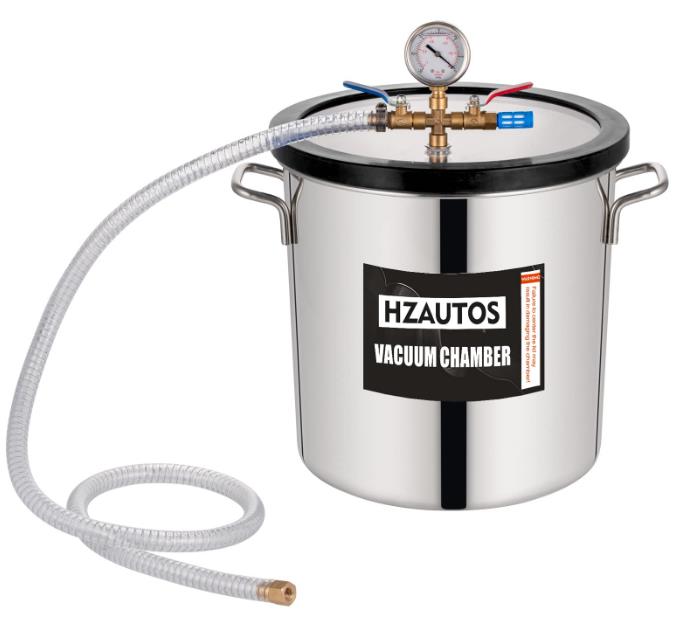Both vacuum and pressure have their benefits in resin casting. Vacuum removes air bubbles, while pressure reduces voids and improves curing.
Understanding Resin Casting Methods
Overview of Vacuum Casting
Vacuum casting is a process used primarily for producing intricate designs with high-quality finishes. It involves placing a silicone mold in a vacuum chamber and then pouring the resin into the mold. The vacuum removes air bubbles and ensures a bubble-free and detailed final product.

Cost Efficiency: More cost-effective for small batches, with typical setup costs ranging from $1,000 to $5,000.
Material Compatibility: Works well with a variety of resins, especially those prone to air bubble entrapment.
Quality and Precision: Offers high precision and detail, ideal for prototypes and small series production.
Limitations: Not suitable for large-scale production due to time and process constraints.
Overview of Pressure Casting
Pressure casting, on the other hand, involves injecting resin into a mold under high pressure. This method is highly effective for mass production.
Efficiency: Suitable for large-scale production with shorter cycle times compared to vacuum casting.
Cost Implications: Higher initial setup costs, often exceeding $10,000, but lower per-unit cost for large volumes.
Material Suitability: Ideal for thermosetting plastics that benefit from pressure to achieve uniformity.
Speed and Durability: Produces parts quickly and ensures durability, but may have issues with air entrapment.
Both vacuum and pressure casting have distinct advantages and limitations, making them suitable for different types of resin projects.
For further information about resin casting methods, their applications, and technical details, explore the Wikipedia page on Resin Casting.
Comparative Analysis: Vacuum vs. Pressure in Resin Casting
Efficiency and Quality Comparison
| Factor | Vacuum Casting | Pressure Casting |
|---|---|---|
| Efficiency | Better for small batches. | More efficient for large-scale production. |
| Cycle Time | Longer cycle times due to vacuum process. | Shorter cycle times, suitable for mass production. |
| Quality | Higher detail precision, ideal for complex designs. | Good for simpler designs, may have air entrapment. |
| Cost for Setup | Lower initial setup cost ($1,000 – $5,000). | Higher setup cost (over $10,000). |
| Cost per Unit | Higher for small quantities. | Economical for large quantities. |
Material Compatibility and Limitations
| Factor | Vacuum Casting | Pressure Casting |
|---|---|---|
| Materials Used | Works with a wide range of resins. | Best suited for thermosetting plastics. |
| Air Entrapment | Minimal due to vacuum process. | Possible, affecting material consistency. |
| Scale Limitations | Not ideal for large-scale production. | Highly effective for large-scale production. |
| Durability | Produces parts with high-quality finishes. | Ensures part durability but may lack fine details. |
Both vacuum and pressure casting methods offer distinct advantages and suit different production needs and material types in resin casting.
For more detailed insights into vacuum and pressure resin casting methods, their efficiency, and material compatibility, you can visit the Wikipedia page on Resin Casting.
Technical Aspects of Vacuum and Pressure Casting
Mechanisms and Equipment Used
Vacuum Casting:
- Vacuum Chamber: Creates an air-free environment to prevent air bubbles.
- Mold: Typically made of silicone, accommodating complex shapes and details.
- Material: Uses resins that can flow under minimal pressure.
- Cost: Initial setup costs around $1,000 to $5,000, depending on the size and complexity.
Pressure Casting:
- Pressure Chamber: Applies high pressure to force resin into the mold.
- Mold: Usually metal, designed to withstand high pressure.
- Material: Suitable for thermosetting plastics that require pressure to cure evenly.
- Cost: Setup costs can exceed $10,000 for advanced systems.
Process Variables and Control
Vacuum Casting Variables:
- Vacuum Level: Must be precisely controlled to avoid defects.
- Temperature: Key for ensuring proper flow and curing of the resin.
- Pouring Rate: Critical to maintain to prevent turbulence and air entrapment.
Pressure Casting Variables:
- Pressure Level: Typically ranges from 30 to 70 psi, crucial for material flow.
- Temperature Control: Higher temperatures needed for thermosetting plastics.
- Injection Speed: Faster than vacuum casting, impacting the final product quality.
Both processes require careful monitoring and control of variables to ensure optimal outcomes.
For more comprehensive knowledge about the technical aspects of vacuum and pressure casting, including machinery and process control, consider exploring this Wikipedia page on Resin Casting.
Troubleshooting and Optimization Techniques

Addressing Common Issues in Vacuum Casting
Air Bubbles in Casts: To minimize air bubbles, ensure a complete vacuum is achieved before pouring the resin. Consider using a slower pouring rate to reduce turbulence.
Incomplete Curing: If the resin isn’t curing properly, check the temperature in the vacuum chamber and the resin’s mix ratio. Adjusting the ambient temperature or changing the resin mix can help.
Mold Degradation: Use mold release agents to extend mold life and reduce wear. For silicone molds, monitor for signs of degradation after about 20-30 uses.
Addressing Common Issues in Pressure Casting
Material Inconsistency: Ensure the resin is at the correct temperature for optimal flow. Adjust pressure settings to ensure even distribution of the resin in the mold.
Short Shots: This issue, where resin fails to fill the mold, can be addressed by increasing the injection pressure or pre-heating the mold to maintain resin fluidity.
Warping or Distortion: This occurs due to uneven cooling. Implement a more gradual cooling process and ensure the mold temperature is uniform.
Both vacuum and pressure casting methods have their unique challenges, but with proper techniques and adjustments, these issues can be effectively addressed.
For a more in-depth understanding of troubleshooting in resin casting, you might find the Wikipedia page on Resin Casting informative.




